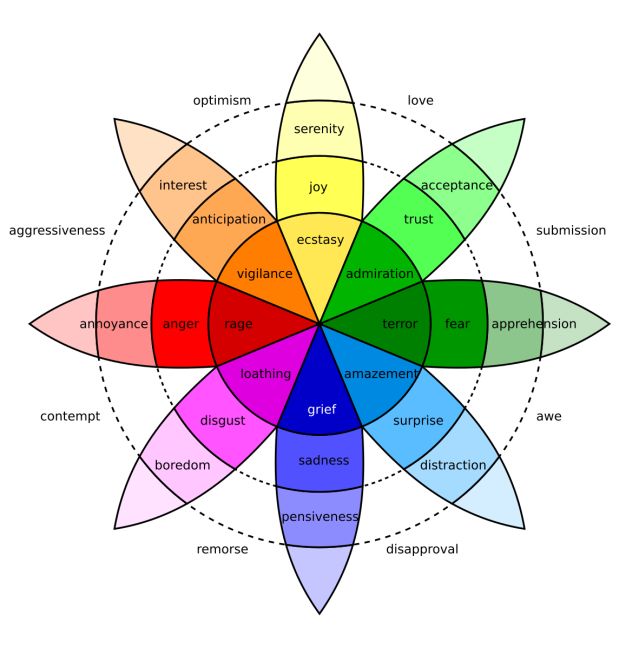What Are Basic Emotions?
Neel Burton M.A., M.D. | Posted June 24, 2024 | Reviewed by Lybi Ma
Key Points
- Basic emotions are innate and automatic, and trigger behaviour with a high survival value.
- They evolved in response to the ecological challenges faced by our remote ancestors.
- Although they are ‘hardwired’, their potential objects are open to cultural conditioning.
The concept of ‘basic’ or ‘primary’ emotions dates back at least to the Book of Rites, a first-century Chinese encyclopaedia that picks out seven ‘feelings of men’: joy, anger, sadness, fear, love, disliking, and liking.
In the 20th century, Paul Ekman identified six basic emotions (anger, disgust, fear, happiness, sadness, and surprise) and Robert Plutchik eight, which he had in oppositional pairs (joy-sadness, anger-fear, trust-disgust, surprise-anticipation).
Basic emotions are thought to have evolved in response to the ecological challenges faced by our remote ancestors and are so primitive as to be ‘hardwired’ into the brain, with each one operating along its own dedicated neurological circuit. Being hardwired, basic emotions (sometimes also called ‘affect programs’) are innate, automatic, and fast or reactive, and trigger behaviour with a high survival value.
One day, while holidaying on the tropical island of Mauritius, I opened a cutlery drawer on a large lizard, which, of course, I had not been expecting to find in among the knives and forks. As the critter darted off into the darkness behind the drawer, I immediately and unthinkingly jumped back and slammed the drawer shut. Having done so, I suddenly became aware of feeling hot and alert and primed for further action. This basic fear response is so primitive that even the lizard seemed to share in it, and so automatic as to be ‘cognitively impenetrable’, that is, unconscious and uncontrollable, and more akin to a reflex or reaction than to a deliberate action. As soon as reason could reassert itself, my fear disappeared, leaving me with nothing more than a mildly inconvenient lizard problem, which, I think, I chose to ignore.
One hypothesis is that basic emotions can function as building blocks, with more complex emotions being blends of basic ones. For instance, contempt might amount to a blend of anger and disgust. In 1980, Plutchik constructed a wheel-like diagram of emotions with eight basic emotions, plus eight derivative emotions each composed of two basic ones. However, many complex emotions cannot be deconstructed into more basic ones, and the theory does not explain why infants and animals do not share (or appear to share) in complex emotions.
Instead, it could be that complex emotions are an amalgam of basic emotions and cognitions, with certain combinations being sufficiently common or important to be named in language. Thus, frustration might amount to anger combined with the thought or belief that ‘nothing can be done’. But again, many complex emotions resist such analysis. What’s more, ‘basic’ emotions can themselves result from quite complex cognitions, for instance, Tom’s blind panic upon realizing, or simply believing, that he has slept through an important exam.
Although basic emotions have been compared to programmes, it does seem that their putative objects are open to cultural conditioning. If poor Tom so fears having missed his exam, this is in large part because of the value that his culture and sub-culture attach to academic success.
With more complex emotions, it is the emotion itself (rather than its object) that is culturally shaped and constructed. Schadenfreude [German, lit. ‘harm-joy’: the joy or pleasure derived from the misfortune of another] is not common to all peoples in all times.
Neither is romantic love, which seems to have emerged in tandem with the novel. In Madame Bovary, itself a novel, Gustave Flaubert tells us that Emma Bovary only found out about romantic love through “the refuse of old lending libraries.”
Original Post: What Are Basic Emotions?
Copyright belongs to the original author.
什么是基本情绪?
Neel Burton M.A., M.D. | 2024年6月24日 | 审阅:Lybi Ma
重点
- 基本情绪是天生且自动的,它们会引发具有高度生存价值的行为。
- 它们是在远古祖先面临的生态挑战中进化而来的。
- 尽管它们是“硬连接”的,但其潜在对象可以受到文化条件的影响。
“基本”或“主要”情绪的概念至少可以追溯到《礼记》,这本一世纪的中国百科全书列出了人的七种”情感”:喜、怒、哀、惧、爱、恶、欲。
译者注:《礼记·礼运》:“何谓人情?喜、怒、哀、惧、爱、恶、欲,七者弗学而能。”
在20世纪,保罗·艾克曼(Paul Ekman)确定了六种基本情绪(愤怒、厌恶、恐惧、快乐、悲伤和惊讶),而罗伯特·普鲁奇克(Robert Plutchik)则提出了八种基本情绪,并将它们成对对立(如快乐-悲伤,愤怒-恐惧,信任-厌恶,惊讶-期待)。
人们认为基本情绪是在远古祖先面临的生态挑战中进化而来的,它们是如此原始,以至于“根植于”大脑中,每种情绪都沿着其专属的神经通路运作。 由于是固有的,基本情绪(有时也称为“情感程序”)是天生的、自动的、快速或反应性的,能够引发具有高度生存价值的行为。
有一天,当我在毛里求斯的热带岛屿度假时,我打开了一个装餐具的抽屉,发现了一只大蜥蜴,当然,我没想到会在刀叉中找到它。 当那只蜥蜴飞快地逃进抽屉后面的黑暗中时,我立刻不假思索地跳了回来并猛地关上了抽屉。 做完这一切后,我突然意识到自己感到身体发热、警觉,并为进一步的行动做好了准备。 这种基本的恐惧反应是如此原始,以至于连蜥蜴似乎都能共享这种反应;它是如此自发,以至于是“认知上无法理解的”,即无意识且无法控制,更像是一种反射或反应,而非有意的行动。 一旦理智重新占上风,我的恐惧随即消失,只留下了一个有点不便的蜥蜴问题,我想,我选择了忽略它。
一种假设认为,基本情绪可以作为构建模块,更多复杂的情绪是基本情绪的混合。 例如,蔑视可能是愤怒和厌恶的混合体。 1980年,普鲁奇克构建了一个类似轮子的情绪图,展示了八种基本情绪,以及由两种基本情绪组合而成的八种派生情绪。 然而,许多复杂的情绪无法被分解为更基本的情绪,且这一理论无法解释为什么婴儿和动物没有(或似乎没有)复杂情绪。
相反,复杂情绪可能是基本情绪与认知的融合,某些组合在语言中足够普遍或重要,以至于被命名。 因此,沮丧可能是愤怒加上“无能为力”的想法或信念。 但是,许多复杂的情绪仍然无法通过这种方式进行分析。 此外,“基本”情绪本身可能源自相当复杂的认知,例如,汤姆意识到或仅仅认为,自己错过了重要考试时产生的盲目恐慌。
尽管基本情绪常被比作程序,但似乎它们的假定对象可以受到文化条件的影响。 如果可怜的汤姆如此害怕错过考试,很大程度上是因为他的文化和亚文化对学术成功的重视。
对于更复杂的情绪,情绪本身(而非它的对象)是由文化塑造和构建的。 例如,Schadenfreude(德语,意为“幸灾乐祸”:从他人不幸中获得的快乐或愉悦)并非所有时代所有民族共有的情感。
浪漫爱情也不是,它似乎伴随着小说的出现而产生。 在小说《包法利夫人》中,居斯塔夫·福楼拜告诉我们,艾玛·包法利是通过“旧借书店的废物”才了解浪漫爱情的。
原文链接: What Are Basic Emotions?
版权属于原作者,本翻译仅供学习用途。
Enjoy Reading This Article?
Here are some more articles you might like to read next:
